A kite is a simple structure with wing surfaces against air current, thus, creating lift and drag forces. Kites often have a bridle and tail to steer the front of the kite so the wind can lift it. However, not all kite designs need a bridle. Below, you will find a beginner-friendly guide on how to fly a kite.
History of Kite flying
Kites were invented in Asia. The oldest depiction of a kite is visible on the cave walls in Muna Island, Sulawesi, Indonesia. These islands date. These islands date back to 9000 BC. Kites in the ancient era were made of leaf, bamboo skin and plant fibre. Muna people specifically used the kolope leaf for the wings and pineapple fibre as rope.
In China, kites were invented in the 5th century by Chinese philosophers Mozi and Lu Ban. Materials used were silk and snail material for the wings and string as well as bamboo for the frame. By 549 AD paper kites became more popular. The earliest Chinese paper kites were flat and rectangular. Furthermore, they were generally decorated with mythological images and legendary figures. Some were even fitted with whistles to make musical sounds while flying.
Kites were bought to India through the Sil Route. The earliest documented accounts of a kite can be found in the poetry of the thirteenth-century Marathi saint, Namadeva. In his poems, he called the kite a gudi. Furthermore, during the Mughal rule, kite flying became a sport. This still carries on today. People flay a kite during festivals like Uttarayan or Makar Sankranti, as well as on Basant Panchami and Baisakhi in Punjab.
Kits also have a part in the political movement of India. People tell stories of the time several people from India protested against the Simon Commission that was put in place in November 1927, by flying hundreds of kites in the air. This was done as kits symbolise freedom. It was this act that led to the tradition of flying kites on the rooftops of old Delhi on Independence day.
Kite Flying Guide: Requirements
The Perfect Kite
There are a variety of kites to choose from. You can choose from different shapes, sizes and patterns. Each kite offers a different flying experience. Below are the different types of kites available.
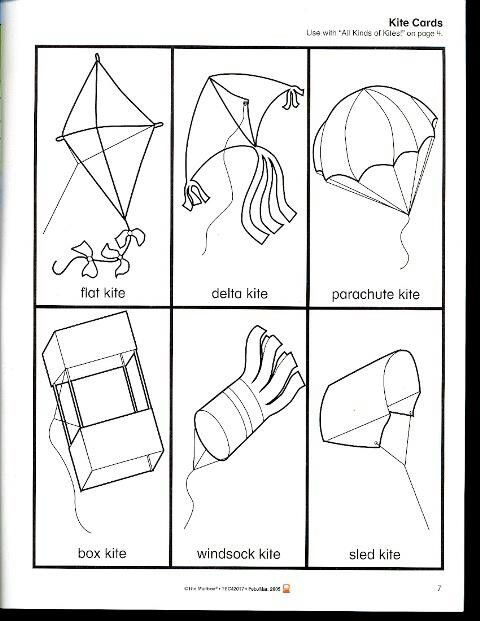
Your choice of the kite also depends on the speed of the wind. But hand, strong wings, 15 to 25 miles per hour, best suit the box or Parafoil kite. In addition, you can also make your very own kite at home. If you choose this option, test your kite to see what wind speed allows for the best flying experience.
The Ideal Weather Conditions
Perfect weather is the most essential when it comes to flying a kite. If the weather is breezy, but not enough to blow things over, then it is for flying a kite. While checking for the right weather, also ensure that there is no lightning or rain.
The Right Place

The right location is just as important as the right weather. You need a location away from trees, buildings, telephone wires etc for the kite to soar in the sky. Locations like the park, beaches, a terrace or fields are the best bet.
Pre Kite Flying Checks
Check the Wind
As mentioned previously, the speed of the wind is crucial for flying a kite. Thus, you have to ensure that the wind speed is optimum. Most kites are made to fly at a wind speed of four to 10 miles per hour. Therefore, if you feel the wind on your face, then it is probably enough to fly a kite. Look for rustling leaves and waving flags. An easy guide to follow is given below.
| Type of wind | Wind speed | Resulting action |
| No or less wind | 0 to 4 kilometres per hour | Trees hardly move |
| Light breeze | 4 to 7 kilometres per hour | Tree leaves rustle and slags move slowly |
| Natural good wind | 8 to 12 kilometres per hour | Flags fly, bushes shake |
| Very strong winds | Over 12 kilometres per hour | The whole tree is swaying, or you can hear a flag flapping |
In 1805, British admiral, Sir Francis Beaufort developed a wind scale to help sailors estimate the wind speed by observing their surroundings. You can successfully fly a kite Force 3 and Force 4 on the Beaufort wind scale. However, with the right preparations and equipment, you can also fly a kite at Force 2 or Force 5.
Beaufort wind scale for light winds
| Force | Wind | WMO | The appearance of Wind Effects | |
| (Knots) | Classification | On the Water | On Land | |
| 0 | Less than 1 | Calm | The Sea surface is smooth and looks like a mirror | Calm, smoke rises vertically |
| 1 | 01-Mar | Light Air | Scaly ripples and no foam crests | Smoke drift indicates wind direction |
| 2 | 04-Jun | Light Breeze | Small wavelets are present, crests are glassy with no breaking | The wind felt on face, leaves rustle, vanes begin to move |
| 3 | 07-Oct | Gentle Breeze | Large wavelets appear, crests begin to break, scattered whitecaps | Leaves and small twigs constantly moving, light flags extended |
| 4 | Oct-16 | Moderate Breeze | Small waves of height 1 to 4 ft., numerous whitecaps | Dust, leaves, and loose paper fly up, small tree branches move |
| 5 | 17-21 | Fresh Breeze | Moderate waves of 4 to 8 ft, many whitecaps, some spraying | Small trees with leaves begin to sway |
Beaufort wind scale for strong winds
| Force | Wind | WMO | The appearance of Wind Effects | |
| (Knots) | Classification | On the Water | On Land | |
| 6 | 22-27 | Strong Breeze | Larger waves of 8 to13 ft, whitecaps are common, more spraying | Larger tree branches move and whistling in wires is heard |
| 7 | 28-33 | Near Gale | Sea heaps up, waves are 13 to19 ft in height, white foam streaks off breakers | Whole trees move and resistance is felt when walking against the wind |
| 8 | 34-40 | Gale | 18 to 25 ft high waves, edges of crests begin to break into spindrift, foam blown in streaks | Twigs breaking off trees, generally impedes progress |
| 9 | 41-47 | Strong Gale | High waves of 23 to 32 ft, the sea begins to roll, dense streaks of foam, the spray may reduce visibility | Slight structural damage occurs and slate can blow off roofs |
| 10 | 48-55 | Storm | Very high waves, approximately 29 to 41 ft high with overhanging crests, sea white with densely blown foam, heavy rolling, lowered visibility | Seldom experienced on land, trees were broken or uprooted |
| 11 | 56-63 | Violent Storm | Exceptionally high waves of up to 53 feet, foam patches cover the sea, visibility more reduced | |
| 12 | 64+ | Hurricane | Air-filled with foam, waves over 45 ft, sea completely white with driving spray, visibility greatly reduced |
Check the kite
Before you fly the kite, check it to ensure that it is in order and not damaged. Furthermore, check if you have the right type of kind for the winds you are experiencing.
How to fly a kite: For Beginners
Running with a kite till it flies is fun, but not very safe. You can not watch where you are going and hence, might trip and hurt yourself. This method is also not suitable if you are in a small space like a terrace. Thus, you need a better, step by step way, to fly a kite.
Launching the kite

Stand with your back to the wind current and hold the kite as high up as you can. Ensure that the nose is pointing straight up. Then, gently let it go, don’t throw it into the air. However, soon, the kite will begin to drop. Then, just before it reaches the ground, pull on the line. Also, your kite will rise again. Repeat this process until the kite goes high enough to experience steady winds.
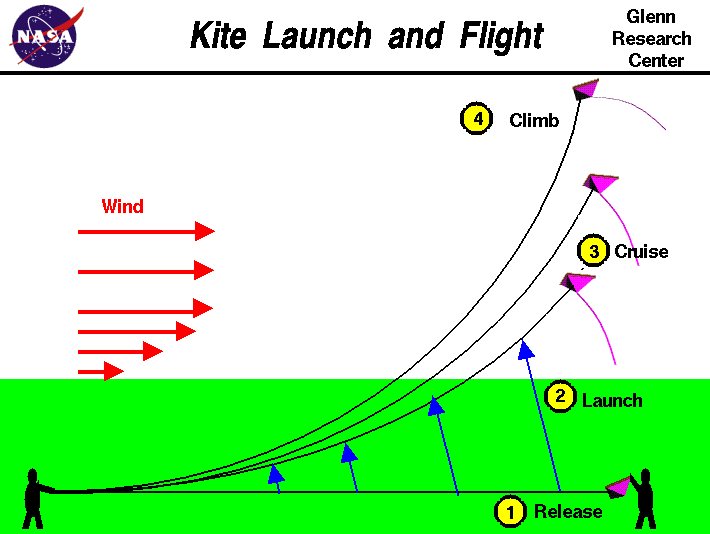
Then, ask them to release the kite as you pull in on the flying line. The kite should immediately rise into the sky. Once the kite reaches a certain height, let the line loose and pull it again to gain altitude.
Flight control
Now that you have your kite up in the air, you need to focus on keeping your kite there. Keep an eye on your kite so that if anything happens you can fix it before a crash.
Let your kite fly about two hundred feet above the ground. If the kite begins to act unstable or pull very hard, let some line out to stabilize it. On the other hand, if the line becomes slack, bring it in a little. Ensure that you are flying the kite. Do not let it fly by itself.
Getting the kite down

When it is time to get your kite down, slowly wind the line onto your reel. If the wind gets lighter, you may need to pull it down more quickly. Drop the string onto the ground in big loose loops so that you can find it later. If the wind becomes stronger, tie the line onto a heavy solid anchor. Then walk towards the kite, pulling it down as you go. Wear gloves to keep the string from cutting your hands. If the kite becomes difficult to pull, let out the line a little so that the kite is temporarily stabilized. If the kite starts spinning as it falls, waits till it approaches the ground and then let out the line very quickly. The extra slack allows the kite to fall gently.
Some things to keep in mind when flying a kite
Buy a good kite flying line
You can buy kite flying lines at the same place you buy kites. A special line is lighter, thinner and stronger. If your line is too thick it will drag in the wind, thus, making your kite fly lower.
Adjusting the kite for different winds
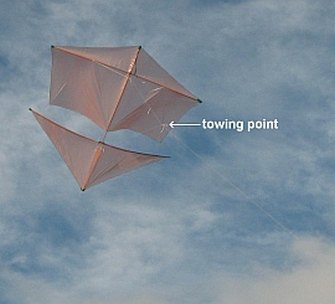
Most kites can be modified for different types of wind. Adjustments are made by altering the point where your flying line connects to the kite. Usually, this point is about one third from the top. By moving the point slightly, you change the angle at which the kite leans into the wind. More leaning will decrease the pull and thus, allow stable flying in strong winds. On the other hand, leaning less will cause the sail to catch more breeze. This is beneficial if the winds are light. Leaning the kite too forward or backward can cause it to flip and crash or not fly at all.
Bail and bow design
Apart from making a kite beautiful to look at, tails also have a special purpose, that is, to keep the nose pointed to the sky and add stability. Thus, if your kite is unstable, try adding a tail. If the kite is dragged back to the ground, reduce the length of the tail. Remember balance is key.
Add the tail to the centre of the kite. However, if you wish to add more, ensure that they are of the same length and equidistant from the centre.
The bow of the kite is also just as important. A bow is a string that runs from one side to the other. It keeps the edges of the kite bent back, thus letting it fly better. The wind will go over the curved surface and allow the kite to go up. Similar to the tail, it helps keep your kite balanced in the sky. If the winds are strong, increase the amount of bend by tightening the bowstring. During light winds, loosen the bow.
Tangles
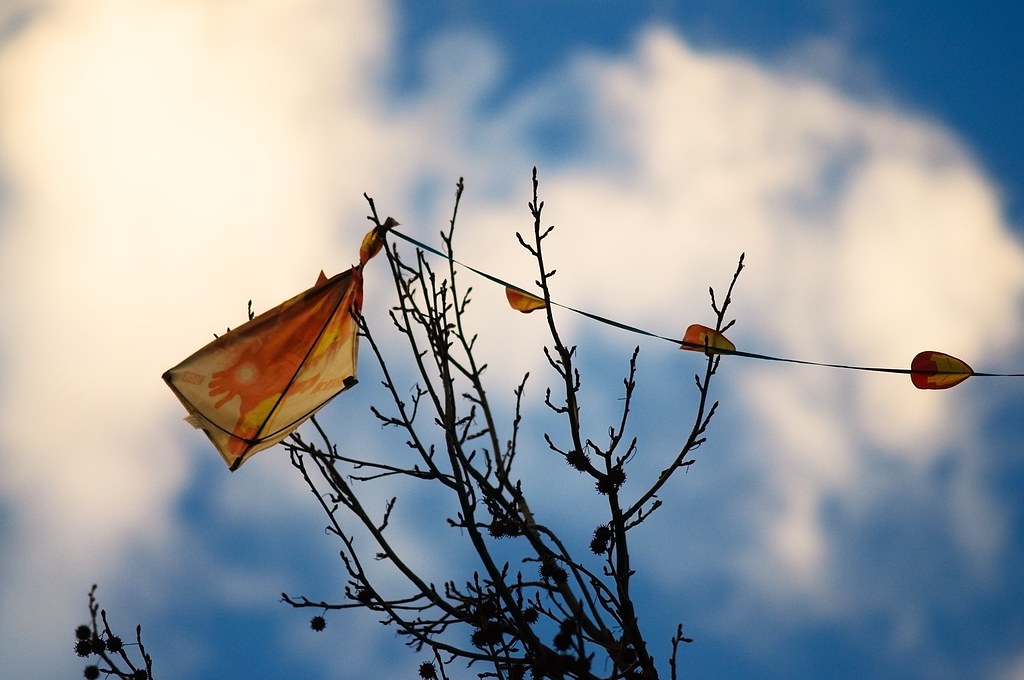
Sometimes you may end up tangles in the line or your kite in a tree. Don’t panic. If your kite is in a tree, don’t pull on the line, as this may break the kite. Additionally, don’t climb the tree, as you may fall and get hurt. Instead, let the wind carry your kite past the tree. Then, let loose enough line to bring it to the ground safely. Detach the kite and drag the line back through the tree.
If your line wraps around another kite’s line, simply walk over to the other flier. The twist will come right down to where you are and thus, can be easily unravelled.
If your line gets tangled on the ground, then patiently undo the mess.
Why won’t my kite fly?
If your kite isn’t flying properly, you may have one of the following issues.
Too High or Low Wind
There may be too much or not enough wind. The amount of wind you require depends on the structure of your kite. Furthermore, if your kite uses a tail, try adding or reducing its length in different winds.
Tuned Out
Remember to adjust the tow point on your kite for different winds. This process is known as ‘tuning’. If your tow-point is too low or too high, your kite won’t fly. Instead, try placing the two-point about 1/3 from the top of the kite for optimum tuning.
Looping
If your kite loops around in circles, add a tail, tighten the bowline or adjust the tow-point. If your kite won’t lift, adjust the tow-point, reduce tail, or loosen the line. Also, ensure that your flying line is thin, dry and light.
Unstable kite
Winds close to the ground are not as good as the winds fifty feet higher. Thus, to get a good launch and smooth flying, get your kits up in higher winds.
Technical Difficulties
If no adjustment or correction is working, make sure that your kite is put together correctly. Thoroughly read the instructions that come with your kite.
FAQs
Can you fly a kite without wind?
No, it is impossible to fly a kite with no wind. A kite needs airflow to lift off the ground and stay airborne. If there is no wind on the ground, you may need to run forward to get the kite to climb up to where there is steady wind.
What does the phrase fly kite mean?
When someone is flying a kite, it means that they are putting forward new ideas just to see how the public reacts, rather than with the intention of practising those ideas.
How to make a kite?
Materials required
- A rectangular piece of paper. You can use an A4 sheet and decorate it as you like.
- A string or reel of cotton
- A hole punch or a sharp object to make a hole in the paper
- Sticky tape
- Decorations like glitter or colours, markers etc
- A pen or pencil
- Stapler
Steps:
1. Bring the two short sides of your paper together and press along the centre to make a crease.
2. Now, decorate the paper. Use pens, pencils, crayons, felt-tip pens, a printer etc. Just remember to not weigh it down too much as it won’t fly if it is too heavy.
3. Bend the front corner of the above layer down and touch the crease. Repeat the same of the back layer and staple it. It is essential to bend the corners down. Do not fold and crease the kite. It won’t fly if you do. The exact position of the corner is not vital but will impact how your kite flies.
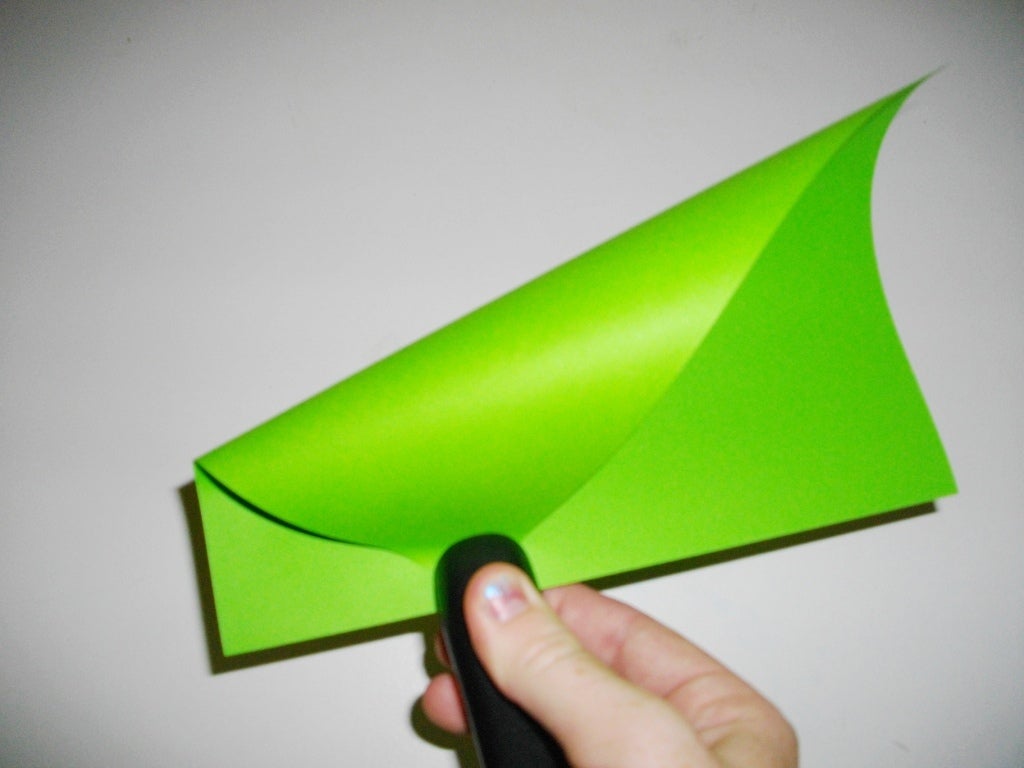
4. If you do not have a stapler, you can also pierce through the two corners as well as the body of the kite to make a hole. The exact position of the hole is not vital, but it will influence how the kite flies.
5. Thread a string through the hole and tie it. The type of knot used is not important as long as it keeps the string attached to the kite. Tape the hole to secure the string in place.
Then, wrap the string around a pen, pencil or stick for ease of handling.
If you do not have a hole, then staple the string to the kite.
6. Fly your kite.
Go to a location with a lot of breezes. Ensure that you are away from people, buildings and trees and fly your kite. To do so, release your kite with one hand while holding the line in the other. Your kite should take off.
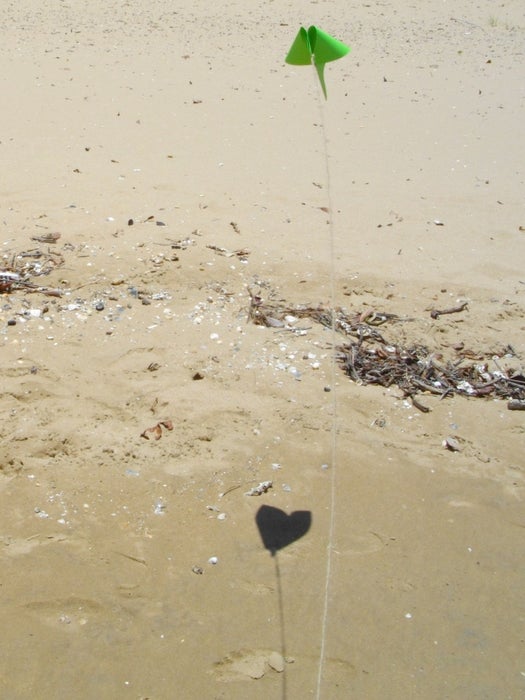
Other ways to make a kite
What are some safety precautions one must follow when flying a kite?
- Do not fly your kite near people, especially young kids.
- Don’t fly close to roads as landing a kite there could cause serious accidents.
- Stay clear of electric power lines and signs as well as TV and radio aerials
- Don’t fly a kite near an airport.
- Don’t fly your kite in extremely strong winds. Also, do not fly a kite in stormy weather.
- Always wear gloves when flying in strong winds as hard-pulling kites can cut your skin.
- Ensure that there are no dogs around when you land your kite as they tend to bite it.
- Don’t let a young kid fly a kite that requires more than a 30-pound flying line.
- Watch out for rocks and uneven surfaces while running with your kite.
- Choose to abandon a kite rather than risking your life to rescue it from trees or telephone poles.
How do you make a kite fly higher?
Hold your kite up by the bridle and release the line. If there is enough wind, your kite will fly right up. Let the kite fly away from you and then pull on the line so that the kite points up. This will help it fly higher. Repeat this process until your kite reaches the altitude where a steady wind is present.
Why do you fly kites?
Kites may be flown for recreation, art or practical uses. Sport kites are flown in aerial ballet, and sometimes also as part of a competition. Power kites refer to multi-line, manoeuvrable kites, developed to create large forces to power activities such as kite landboarding, kite surfing, kite buggying and snowkiting.
Parting words
To know more, do visit Podium School
Share with your friends







